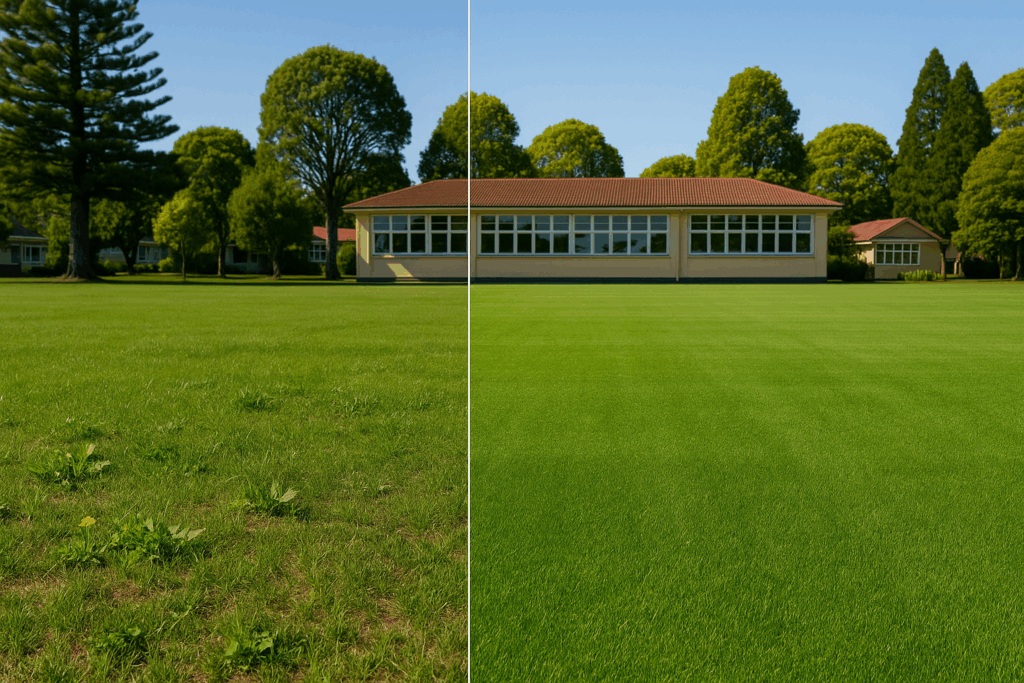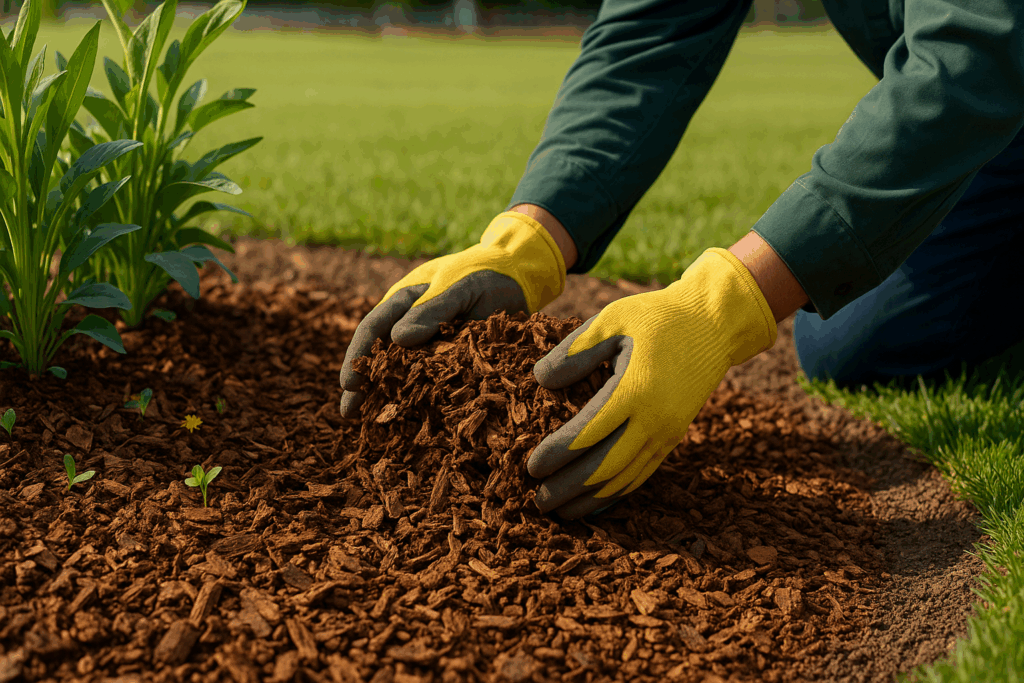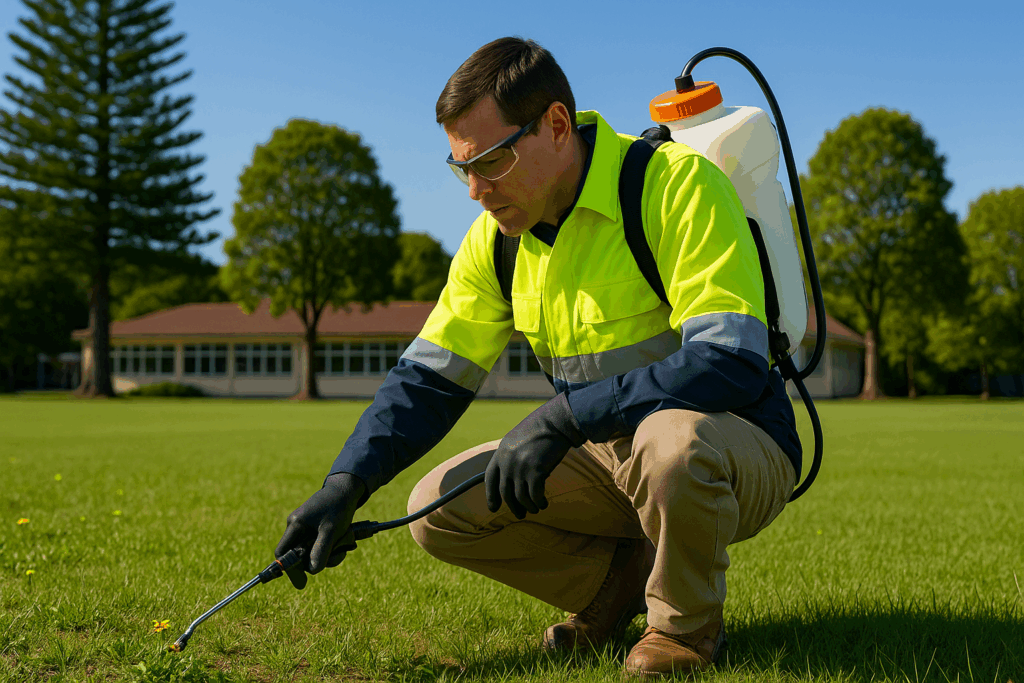Spring Weed Control Guide
Key Takeaways
- Spring is the critical window for weed control in Auckland — intervene early before roots deepen or weeds seed.
- Auckland’s mild, humid climate promotes rapid weed growth, demanding proactive, not reactive, management.
- Schools, councils, and community spaces benefit from structured, season-specific maintenance to keep environments safe, tidy, and compliant.
- Strategic spring intervention saves money by avoiding emergency treatments and long-term damage.
As temperatures rise, Auckland’s parks, school fields, and public spaces experience explosive weed growth. Proactive management during spring ensures healthy, visually appealing landscapes that stay safe, compliant, and low-maintenance throughout the year.
Why Spring Weed Control in Auckland Matters?
Key Point: Spring represents the critical intervention window for Auckland—treating weeds when actively growing but not yet established reduces long-term maintenance costs by 60-70%, protects native plants, eliminates safety hazards like toxic ragwort, or woody weeds that grow into trees, such as Privet ( Ligustrum Vulgare) and prevents seed production that guarantees future infestations.
The Economic Case for Early Action
Auckland’s mild, humid spring conditions create ideal environments for both desirable plants and problematic weeds. Early spring intervention prevents established weed problems that require expensive remedial treatments later in the season.
Cost comparison: Council parks and school grounds benefit from predictable maintenance budgets rather than emergency weed control expenses that strain operational resources. Treating weeds in spring costs significantly less than battling established populations throughout summer and autumn.
Environmental and Safety Benefits
Environmental advantages: Protecting native plant communities from invasive competition while reducing overall herbicide requirements through strategic timing and targeted application methods. Healthy, weed-free landscapes support biodiversity objectives while creating attractive public spaces that enhance community amenity values.
Public safety considerations:
- Eliminating toxic weeds like ragwort from school grounds and parks
- Preventing slip hazards from invasive grasses on playing surfaces
- Maintaining clear sightlines around playgrounds and sporting facilities
- Removing woody weeds such as Chinese privet (Ligustrum Sinense) and tree privet (Ligustrum Lucidum) that trigger hayfever, or Tobacco weed / Wooly Nightshade (Solanum Mauritanium) that can trigger breathing discomfort.
- Creating resilient landscapes that maintain professional appearance standards
Long-Term Landscape Health
Proactive spring weed control in Auckland creates resilient landscapes that maintain professional appearance standards while supporting educational and recreational objectives throughout Auckland’s diverse public spaces and institutional grounds. Whether you’re a council parks manager maintaining recreational facilities or a school groundskeeper ensuring safe playing areas, implementing strategic spring weed control Auckland programmes protects valuable landscaping investments.

Seasonal Weed Control Strategies
Winter (June – August)
Key Actions: Conduct site-wide surveys, to assess the need for infill planting. Canopy closure is one of the best tools to slow weed growth. If the amenity plants are providing 100% soil coverage (canopy closure) weeds really struggle to grow. The best time to plant most trees, shrubs and grasses in Auckland, is winter.
Early Spring (September – October)
Key Actions: Conduct site-wide weed surveys, apply pre-emergent herbicides, implement mulching programmes, and remove winter weeds before flowering to prevent seed spread.
Critical timing: This is your prevention window. Weeds are emerging but haven’t flowered yet—removing them now stops thousands of seeds from spreading across your site.
Site-wide weed surveys: Document current weed populations and distribution patterns across managed areas. Identify problem species and high-risk zones requiring priority attention.
Pre-emergent herbicides: Apply products that prevent weed seeds from germinating. These create a chemical barrier in the soil that stops weeds before they emerge, reducing visible weed pressure by 60-70% when applied correctly.
Mulching strategy: Apply quality organic mulch to 75-100mm in garden beds and around trees. Mulch reduces weed pressure by 70-80% when applied thoroughly while improving soil health and moisture retention – Top tip: apply slow release fertiliser prior to mulching this ensures your trees, shrubs and grasses have plenty of nutrients in summer.
Winter weed removal: Remove winter annual weeds before they flower and set seed. One flowering chickweed plant can produce 15,000 seeds—removing it before flowering eliminates next year’s problem.
Peak Spring (October – November)
Key Actions: Focus on post-emergent treatments for emerged weeds, manual removal of invasive species, and overseeding lawns to build turf density that naturally suppresses weeds through competition.
Why this matters: This is your main intervention window when weeds are actively growing and most vulnerable to control measures. Herbicides achieve maximum effectiveness during this period.
Post-emergent treatments: Apply selective herbicides to emerged weeds while they’re young and actively growing. Younger weeds absorb herbicides more readily and die faster than established plants with developed root systems.
Best practice timing: Choose calm, dry days to avoid chemical drift and ensure proper uptake. Apply when temperatures are between 10-25°C with no rain forecast for 6-8 hours. Windy conditions waste product and risk damaging desirable plants.
Manual removal strategies: Hand-pull or spot-treat priority invasive weeds that threaten native plantings or create safety hazards. Remove entire root systems to prevent regrowth.
Overseeding lawns: Establish dense turf that naturally competes against weeds. Thick, healthy grass leaves no space for weed establishment—the best long-term weed control is a healthy, competitive plant community.
Late Spring (November – December)
Key Actions: Evaluate early programme effectiveness, apply follow-up treatments to persistent problem areas, plant dense groundcovers, add mulch where needed, and plan ahead for summer’s higher maintenance demands.
Assessment phase: Review which interventions worked and where problems persist. This evaluation informs next year’s programme improvements.
Follow-up treatments: Target areas where initial treatments weren’t fully effective. Some weeds require multiple applications, especially perennials with extensive root systems.
Groundcover establishment: Plant dense, healthy groundcovers in bare areas vulnerable to weed invasion. Living groundcovers provide permanent weed suppression while enhancing landscape aesthetics.
Mulch replenishment: Add fresh mulch to areas where coverage has degraded. Maintain a consistent 75-100mm depth for optimal weed suppression.
Summer planning: Prepare for increased maintenance needs as temperatures rise. Establish monitoring schedules and prepare intervention resources.
Summer Transition (December – January)
Key Actions: Confirm spring programmes achieved target outcomes, establish summer monitoring systems, apply protective mulch to retain soil moisture, and prevent late spring weed re-emergence.
Programme validation: Assess whether spring interventions delivered expected weed control. Document successes and areas needing improvement for next season’s planning.
Summer monitoring systems: Establish regular inspection schedules appropriate to site importance:
- Council/high-profile sites: Weekly monitoring with frequent interventions
- School grounds: Bi-weekly inspections with ongoing spot treatments
- Low-use spaces: Monthly reviews with strategic treatments
Protective mulching: Apply or refresh mulch before summer heat arrives. Mulch prevents late spring weed germination while retaining soil moisture during Auckland’s dry summer months.
Alternative solutions: Consider low-maintenance options like artificial turf for high-traffic areas where weed control demands exceed available resources. This eliminates ongoing weed control needs entirely while providing year-round usability.
Maintenance Checklist
Weekly Tasks (During Spring)
Key Actions: Survey for new weeds, spot-treat emerging growth immediately, and record treatment outcomes for programme evaluation.
Why weekly matters: Catching weeds early when they’re small requires minimal treatment. Waiting allows them to establish, flower, and set seed—turning a small problem into a large one.
Survey methodology: Walk all managed areas systematically, noting new weed emergence, species composition, and distribution patterns. Use consistent routes to ensure complete coverage.
Spot treatment protocol: Apply targeted herbicide or manual removal to new weeds immediately upon detection. Early intervention when weeds are small achieves better results with less product.
Feeding amenity plants: Natural slow release fertilisers such as Bio-Char based slow release granules are a great way to reintroduce carbon back into soils. Slow release means no wastage of nutrients being washed out of soils in periods of heavy rain. An even supply of nutrients delivers canopy closure quicker in newly planted area.
Record keeping: Document treatment locations, dates, methods, products used, and weather conditions. This data drives programme improvements and demonstrates compliance with regulations.
Monthly Tasks
Key Actions: Inspect mulch coverage and condition, evaluate herbicide effectiveness rates, update staff training on emerging threats, and coordinate with professional weed management teams.
Mulch inspection: Check for areas where mulch has degraded below effective depth (75-100mm). Schedule replenishment where needed to maintain continuous weed suppression.
Effectiveness evaluation: Assess whether treatments are achieving target control levels. If not, investigate causes—wrong timing, incorrect application, resistant weed species, or weather factors.
Staff training updates: Review proper identification of priority weeds, safe application techniques, and equipment calibration procedures. Professional development ensures consistent programme quality.
Professional coordination: Schedule consultations with specialist teams for technical support, problem-solving, and access to commercial-grade products and equipment.
Site-Specific Monitoring Frequencies
Recommended inspection schedules:
Council and high-profile sites: Weekly monitoring with frequent interventions. These visible public spaces demand pristine presentation and cannot tolerate weed presence.
School grounds: Bi-weekly inspections with ongoing spot treatments. Balance weed control needs with budget constraints and staff availability while maintaining safe, attractive environments for students.
Low-use spaces: Monthly reviews with strategic treatments. Less-visible areas tolerate some weed presence, allowing resource focus on priority locations.

How to Improve Your Weed Control Programme
Key Point: Enhancing spring weed control in Auckland requires systematic assessment of current effectiveness, identifying specific failure points, and implementing strategic improvements—most programmes fail due to poor timing (treating during the wrong weather) or inadequate prevention (insufficient mulch coverage), not wrong products.
Performance Assessment Methodology
Start with data: Document current weed populations and distribution patterns across managed areas. Quantify the problem before attempting solutions.
Evaluate existing approaches: Review current control programme timing, methods, product selection, and effectiveness rates. Identify what’s working and what isn’t.
Identify problem areas: Map locations where current approaches fail to achieve acceptable results. These hotspots indicate underlying issues—poor drainage, soil compaction, inadequate mulch, or timing problems.
Weather-dependent timing assessment: Analyse whether applications occur during optimal conditions or if scheduling constraints force treatments during suboptimal weather. Poor timing is the most common cause of treatment failures.
Prevention system review: Assess mulch coverage consistency, depth adequacy, and material quality in vulnerable locations. Prevention failures allow weed establishment, which requires expensive intervention.
Strategic Enhancement Approaches
Improve application timing: Focus treatments during optimal weather windows when herbicides achieve maximum effectiveness. This single improvement often delivers 30-40% better results without changing products.
Optimal conditions checklist:
- Windless days (under 10km/h) to prevent drift
- Temperatures between 10-25°C for proper herbicide uptake
- No rain forecast for 6-8 hours post-application
- Appropriate humidity (not too dry, which reduces uptake)
- Weeds actively growing (achieving maximum herbicide absorption)
Prevention system upgrades: Enhance preventive strategies through comprehensive mulching programmes that create consistent weed suppression while supporting soil health and moisture retention for desirable vegetation.
Mulch specifications: Use quality organic materials (composted bark, wood chips) applied to 75-100mm with complete coverage and no gaps. Cheap or thin mulch fails to suppress weeds effectively.
Technology Integration Opportunities
Smart scheduling systems: Optimise treatment timing based on weather forecasts and plant growth stages. Mobile apps and management software help coordinate optimal application windows with staff availability.
GPS mapping: Enable precise treatment records and performance monitoring across large council properties and school campuses. Digital mapping shows exactly where treatments occurred, when, and with what results.
Data-driven decisions: Track programme effectiveness over multiple seasons, identifying patterns and refining approaches based on actual outcomes rather than assumptions.
Staff Training Enhancements
Professional development programmes: Ensure staff can identify emerging weed threats early while applying control methods safely and effectively. Recognition of priority species when they’re small enables proactive intervention.
Expert consultation services: Provide ongoing technical support for difficult problems, new weed threats, or changing regulatory requirements. Professional advice prevents costly mistakes and ensures compliance.
Systematic improvement outcomes: Well-designed enhancement strategies deliver measurably better weed control outcomes while reducing overall programme costs through enhanced prevention and more effective intervention timing. Most programmes achieve 40-60% cost reductions while improving results after implementing strategic improvements.
Best Practices for Weed Control in Auckland
Key Point: Effective spring weed control in Auckland requires following proven protocols that maximise control effectiveness while ensuring safety and environmental protection—application excellence, prevention-first thinking, integrated approaches, and rigorous safety compliance deliver superior results at lower long-term costs.
Application Excellence Standards
Professional herbicide application: Careful weather monitoring ensures treatments occur during optimal conditions for maximum effectiveness and minimum environmental risk.
Weather requirements:
- Wind speed: Under 10km/h to prevent drift onto desirable plants
- Temperature: 10-25°C range for proper herbicide uptake
- Rainfall: No rain forecast for 6-8 hours following treatment
- Plant condition: Weeds actively growing for maximum absorption
- Humidity: Adequate moisture for uptake without runoff risk
Calibration and accuracy: Properly maintained and calibrated application equipment ensures accurate chemical delivery while preventing waste and environmental contamination. Annual calibration confirms the equipment applies the correct rates.
Prevention-First Approaches
Build weed resistance into landscapes: Comprehensive prevention strategies emphasise healthy plant communities and physical barriers that naturally resist weed establishment, reducing long-term control costs.
Mulch specifications: Apply quality organic materials (composted bark, wood chips) to 75-100mm using consistent coverage. Prevent weeds with mulch top-ups that suppress germination while supporting soil health.
Why prevention works: Every dollar invested in prevention saves three to five dollars in control costs later. Preventing weeds is always cheaper than treating established populations.
Competitive exclusion: Establish dense, healthy plant communities that naturally suppress weeds by occupying space, light, water, and nutrients. Thick lawns, groundcovers, and garden beds leave no opportunities for weed establishment.
Integrated Pest Management Principles
Multiple control methods: Combine chemical, mechanical, and biological approaches that provide comprehensive weed management while reducing reliance on any single intervention method.
Integrated approach components:
- Cultural controls: Proper irrigation, fertilisation, and mowing that favour desirable plants
- Mechanical controls: Hand-pulling, mowing, and cultivation where appropriate
- Chemical controls: Strategic herbicide use for maximum effect with minimum application
- Biological controls: Encouraging natural weed enemies and competitive plant communities
Reduced chemical reliance: Integrated approaches typically reduce herbicide use by 40-60% compared to chemical-only programmes while achieving superior long-term results.
Safety and Compliance Protocols
Professional spring weed control in Auckland includes:
Personal protective equipment (PPE): Appropriate clothing, gloves, eye protection, and respiratory protection based on product requirements and application methods.
Accurate mixing and application: Follow label directions precisely for proper dilution rates, application volumes, and timing restrictions. Improper mixing wastes product and risks environmental harm.
Comprehensive record-keeping: Document all treatments, including date, location, products used, rates, weather conditions, and applicator names. Records demonstrate regulatory compliance and support programme evaluation.
Public space requirements: Additional safety measures for schools, parks, and public areas, including signage, restricted access periods, and community notification where required by regulations.
Environmental Stewardship Practices
Targeted application methods: Minimise chemical inputs while achieving superior control results. Spot treatment of individual weeds uses 80-90% less herbicide than blanket applications while often achieving better results.
Strategic landscape design: Create conditions that naturally resist weed establishment through competitive exclusion. Design reduces ongoing maintenance demands permanently.
Native plant integration: Incorporate native species that naturally thrive in Auckland conditions with minimal maintenance while supporting local biodiversity objectives.
Water protection: Implement buffer zones near waterways, wetlands, and storm drains. Prevent chemical entry to water systems through proper application timing and methods.
Monitoring and Adaptive Management
Regular assessment: Enable programme refinement based on actual performance results rather than assumptions. What works in one location may fail in another—adapt to specific conditions.
Professional monitoring benefits:
- Identifies emerging weed threats early, before they establish
- Tracks long-term programme effectiveness across seasons
- Documents cost savings and outcome improvements
- Supports data-driven decision making
Adaptive management cycle: Assess results → identify improvements → implement changes → measure outcomes → refine further. Continuous improvement delivers progressively better results at lower costs.
Equipment Maintenance and Calibration
Proper equipment care: Clean sprayers thoroughly after each use to prevent chemical residue contamination. Store equipment properly to extend service life.
Annual calibration: Verify equipment applies chemicals at correct rates. Miscalibrated equipment wastes product or applies insufficient amounts that don’t control weeds.
Nozzle selection: Use appropriate nozzle types for target applications—drift-reduction nozzles for herbicides, different patterns for different coverage needs.
Systematic excellence: Successful spring weed control in Auckland results from systematic planning, professional implementation, and ongoing management that adapts to changing conditions while maintaining high performance standards.
Bottom Line
Effective spring weed control in Auckland requires strategic timing across four phases (September-January), with early intervention preventing 70-80% of seasonal problems. Successful programmes blend prevention-first approaches (comprehensive mulching), optimal treatment timing (calm, dry days at 10-25°C), integrated methods (combining chemical, mechanical, and cultural controls), and rigorous monitoring (weekly during peak spring).
The spring window matters: Miss early intervention opportunities in September-October, and costs increase exponentially throughout the season as weeds establish deep roots, set thousands of seeds, and require increasingly aggressive treatments with lower success rates.
Programme success factors: Systematic planning, professional implementation following proven protocols, weather-dependent timing flexibility, and ongoing adaptive management that refines approaches based on actual performance results rather than assumptions.
Modern Environments brings proven expertise to Auckland spring weed control challenges. Our team understands optimal application timing for Auckland’s variable weather, implements preventive mulch strategies that deliver 70-80% weed suppression, and follows rigorous safety protocols meeting all regulatory requirements for public spaces.
Whether you’re managing:
- Council parks require pristine presentation standards
- School grounds need safe, attractive environments for students
- Sports facilities where weed-free surfaces ensure playability
- Public spaces serving diverse community recreational needs
- Institutional landscapes reflecting organisational standards
Modern Environments’ spring weed control Auckland programmes deliver superior long-term results through strategic prevention, optimal timing, and professional application that protects your landscape investments with confidence.
Contact our experienced team to develop a customised spring weed control programme that addresses your specific site challenges, achieves target weed suppression outcomes, meets all safety and environmental requirements, and reduces long-term maintenance costs through proven prevention-first strategies adapted to Auckland’s unique conditions.
Don’t wait until weeds establish: Early spring intervention saves 60-70% compared to reactive emergency treatments later in the season when weeds have already flowered, set seed, and created next year’s problems.

